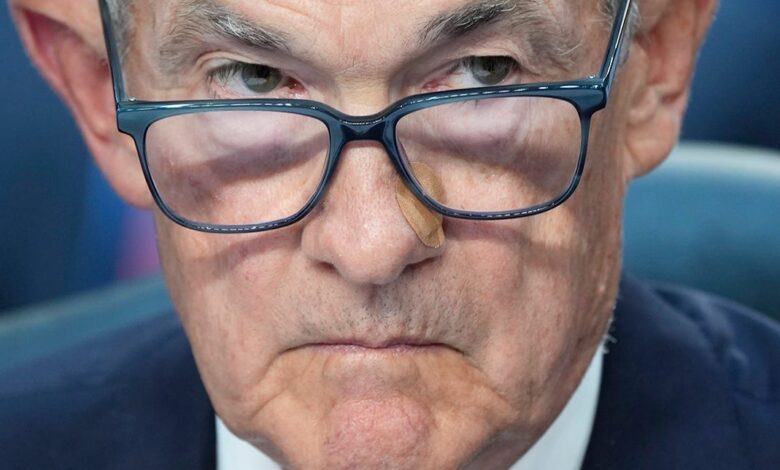Is it time to cut interest rates? Fed meeting live updates

The highest interest rates in a generation may finally ease Wednesday, as the Federal Reserve meets to consider the first rate cut in four years, potentially ushering in a new era of lower borrowing costs for anyone seeking a new home, car or credit card.
In recent comments, Fed Chair Jerome Powell signaled that “the time has come” for an interest rate cut at the group’s September meeting, which concludes today. The looming question is, how big of a cut? Forecasts are split between a reduction of one quarter of a percent and one half to the benchmark federal funds rate, which stands at a 23-year high.
The mother of all interest rates is actually a range, and it has sat at 5.25% to 5.5% since July 2023, following a campaign of rate hikes to combat surging inflation. In response, rates on mortgages, car loans and credit cards have reached historic highs.
The two-day Fed meeting ends at 2 p.m. with a rate announcement. Powell will hold a press conference at 2:30 p.m. The financial world will be watching.
Why would the Fed decrease interest rates?
The central bank reduces interest rates to trim consumer and business borrowing costs, jolting a weak economy or propelling it from recession. It raises rates, or keeps them higher for longer, to dampen growth and bring down inflation. Historic inflation drove the campaign of rate increases in 2022 and 2023, leaving the Fed’s benchmark rate perched at a 23-year high.
Nearly every forecaster expects the Fed to cut rates Wednesday, but economists are split on how large the cut might be: one-quarter point, or half a point. With most Fed moves well telegraphed ahead of meetings, that point of uncertainty provides some rare drama.
“It is a coin toss,” said Nationwide Chief Economist Kathy Bostjancic.
– Paul Davidson
When would a rate cut take effect?
Interest rates don’t magically reset when the Federal Reserve raises or lowers its benchmark federal funds rate.
What, then, should consumers expect in the hours and days after an interest rate cut?
When the Fed lowers rates, it reduces the interest commercial banks pay when they borrow and lend excess reserves to each other overnight, according to Investopedia.
A Fed rate cut doesn’t immediately transform interest rates across the economy. Some types of interest rates take time to adjust. Others, including mortgage rates, have already been falling in anticipation of the Fed cutting rates this week. But many categories of loans react more or less instantaneously, experts say.
“It normally happens the next day,” Nathan Rogge, CEO of First Pacific Bank, told Marketplace. “So, if it was a Wednesday, by Thursday, you would have a different interest rate.”
– Daniel de Visé
What will happen with the stock market?
The stock market has already been rising in anticipation of lower interest rates. Lower rates usually boost stocks, because they allow companies to borrow at a lower cost to invest in and grow their businesses.
The broad Standard & Poor’s 500 index scored its best week of the year last week, and the blue-chip Dow touched a record high during Monday’s trading.
In the most recent rally, investors have expanded their buying beyond the so-called Magnificent Seven stocks of Apple, Amazon, Alphabet, Meta, Tesla, Microsoft and Nvidia. They’re snatching up high-quality dividend utilities, health care, real estate and consumer staples stocks, said Daniel Milan, managing partner at advisory firm Cornerstone Financial Services.
“This expanded breadth from early July is good, healthy for the market,” he said.
– Medora Lee
How high is inflation?
Inflation, a sustained increase in prices throughout the economy, has been well above the 10-year median of 2.1% for more than three years. The Fed policymakers say they prefer a low and stable inflation rate, so they can “make sound decisions regarding saving, borrowing and investment.”
Inflation has fallen significantly in the past two years but remains elevated – largely because of housing costs. In August, the annual inflation rate as measured by the consumer price index fell to 2.5%, from 2.9% in July. The reading was the lowest since March 2021, a year before the Fed started pushing up interest rates.
– Jim Sergent
What can borrowers expect?
If the Fed cuts interest rates today, borrowers will likely see interest rates ease off their peaks on things like credit cards and auto loans, but they shouldn’t expect any great immediate relief, analysts said.
September’s average rate for new credit cards was 24.92%, unchanged from August and the highest since 2019, when LendingTree began tracking the data.
“While they’ll almost certainly fall from record highs in coming months, no one should expect dramatically reduced credit card bills anytime soon,” said Matt Schulz, LendingTree credit analyst. “Barring the Fed unexpectedly stomping on the gas pedal when it comes to lowering rates, credit card APRs are still going to be high for the foreseeable future.”
The same goes for rates on auto loans and other types of debt, he said.
– Medora Lee
How much will the Fed lower rates on Wednesday?
Will the Fed cut interest rates by half a point, or only a quarter point? Forecasters slightly favor a half-point cut, according to the CME’s FedWatch tool, which gauges what sort of interest rate move the market is predicting. As of Wednesday morning, the site showed a 37% probability for a quarter-point cut and a 63% chance of a half-point decline.
– Charisse Jones
When is the next Fed meeting in 2024?
After today’s meeting, the Federal Reserve has two more opportunities to consider interest rate moves in 2024.
The remaining Fed meetings planned for 2024 are scheduled for Nov. 6-7 and Dec. 17-18.
– Medora Lee






